Whether you rock a powerchair or a manual wheelchair, transportation plays a huge role in personal freedom. Sure, there are mobility vans customized for wheelchair users, but not everyone has one.
We’re talking about cars here. How on earth do you pack a wheelchair into the trunk of a small sedan?
In this article, we tell you everything you need to know about how to transport a wheelchair in a car. Let’s get to it!
How to Transport Wheelchair in Car
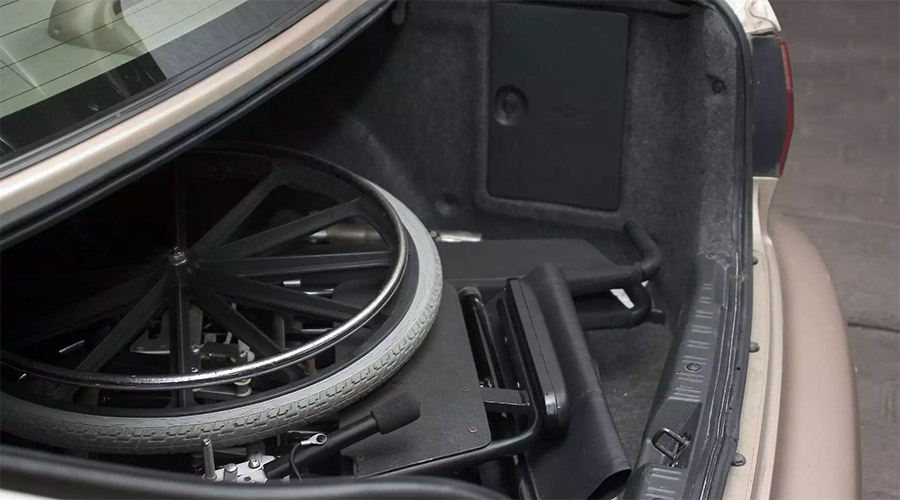
Transporting a wheelchair in a car is as simple as folding it up, packing it in a case, and sliding it into the trunk.
Or is it?
Remember that every wheelchair user has a different disability, and each chair is meticulously designed to accommodate the user’s unique needs.
Wheelchairs are expensive, come in different sizes, and feature special components that may or may not fit in a car.
So, here’s how to plan your transportation one step at a time to reduce the chances of damages or disappointment.
1. Know Your Wheelchair Inside and Out
Do you know what’s not fun? Figuring out how to collapse a wheelchair outside in the rain and then fitting it into the trunk.
It’s incidents like this that make it worthwhile to know everything about the wheelchair first, then you can go through the moves smoothly when it’s time to roll.
Start by learning how to collapse your wheelchair, taking into account the components that come apart.
Note how long it takes to break it down and the number of pieces (such as the leg rests, wheels, or seat) that must be removed.
Once the manual wheelchair is fully collapsed or the powerchair is broken down, take the size and weight into account so that you can compare the measurements with the size of your car’s trunk.
2. If You’re a Caregiver, Understand the Wheelchair User’s Needs
For caregivers, there are extra responsibilities to consider besides the portability of the wheelchair. You also need to ensure the user is comfortable and safe.
As we mentioned, every wheelchair user has different needs, meaning not everyone can maneuver in and out of a car with ease.
This is where driving details become important. You’ll want to be mindful of where you park, making sure there is plenty of space to position the chair by the door where the wheelchair user is sitting.
Before loading up the chair, check for obstructions that could injure the user. The car door must be fully open without the possibility of closing on the individual during the transfer.
Also, give the brakes one last glance to ensure they’re locked before the transfer takes place.

3. Take Note of Your Car’s Transport Capabilities
Finally, you need to decide how the wheelchair will fit inside the car. This is most likely to be in the trunk, so clear your stuff out beforehand.
Observe the amount of space in the trunk and whether the chair will fit easily inside. If the trunk is out of the question, gauge the amount of space behind the passenger’s seat for the chair.
Trucks offer more space since the wheelchair can be lifted into the bed of the truck, but of course, you need to come up with a plan for securing it firmly in place to prevent sliding.
If you’re dealing with a powerchair, you may need help lifting it into the truck bed. Also, check the weather because your wheelchair is exposed to the elements unless your truck bed has a cover.
4. Option One: Stick it in the Trunk
Once you’ve done your homework and are sure the collapsed wheelchair fits snugly in the trunk of the car, you’ll want to slip a carrying case over the entire device.
Some manual wheelchairs come with a carrying case, but if not, this is a worthwhile accessory to invest in that offers optimal protection from damages, dust, and sunlight.
Consider a waterproof wheelchair cover with elasticized edges that cling to the chair without sliding off if you have a powerchair.
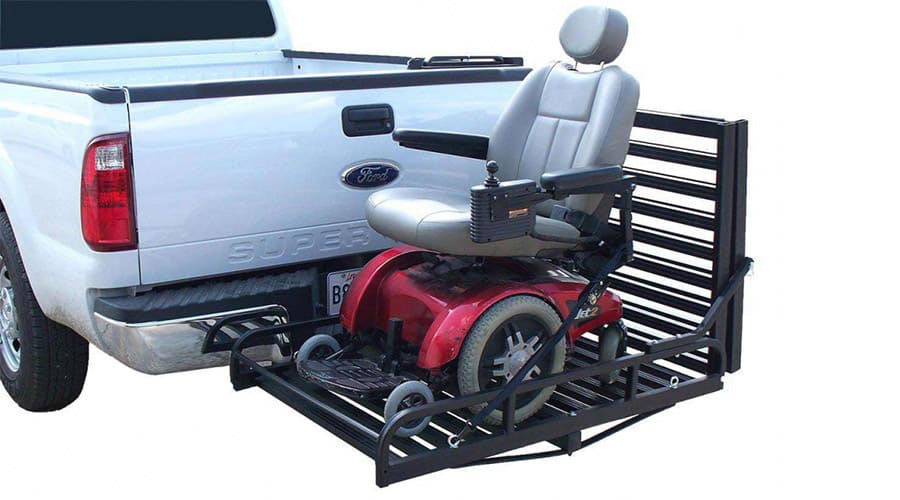
5. Option Two: Install a Rack or Electric Lift
Some powerchairs are hefty, while cars are small. So, a rack or lift might be your best option to transport your wheelchair.
Racks can be mounted on top (affixed to the luggage rack) or mounted on the rear bumper.
Both types are highly reliable and sturdy, but generally, bumper racks tend to be the most user-friendly. That’s because the top rack is going to require lifting the wheelchair overhead to reach the roof.
The beauty of the rack is that it’s a universal system. Even though wheelchairs come in different sizes, you can collapse them or break them down, then seamlessly mount them on the rack.
Once everything is in position, securing the wheelchair is accomplished by either hooking it onto the rack or using a bar to hold it in place while tightening it firmly with wing nuts.
Now, say you’re handling a heavy, high-end powerchair that calls for the utmost care. That’s where an electric lift comes in handy.
This type of lift is positioned on the back of the car like a rack but is unique in that it features a platform that ascends or descends with the push of a button.
When the platform is lowered to the ground, it is easy for the user to roll up onto the platform without any manual lifting required.
The wheelchair is then secured to the platform with straps before lifting it.
Bear in mind that although lifts offer convenience, it’s also one of the most expensive transport options for a car.
6. Option Three: Attach a Trailer
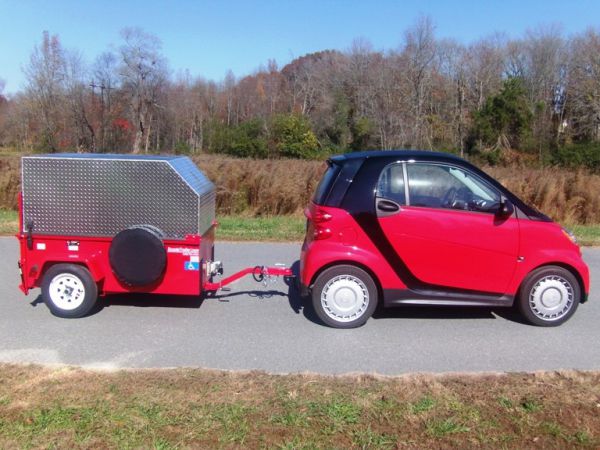
Another dependable transport tool for electric wheelchairs is a small trailer that attaches to the car’s back.
You do need a vehicle with a hitch, though, and you may need a ramp so you can drive the wheelchair up into the trailer without dissembling anything.
To keep the wheelchair from sliding around, tie it down and lock the brakes. Check the trailer’s wiring to confirm that the lights and blinkers are working properly.
A trailer is also expensive. If you have a manual wheelchair, know that there are more affordable transport options, as this type of setup is meant for heavy, bulky devices.
The Best Vehicle for Wheelchair Transport
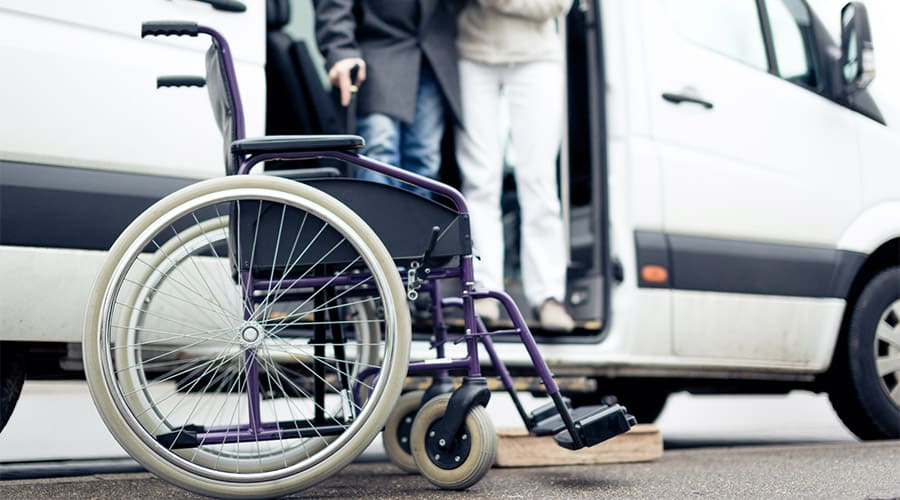
Some wheelchairs pair better with certain types of vehicles. For instance, a transport wheelchair is light enough to fit in most trunks, whether it’s a hatchback, sedan, truck, or SUV.
However, manual wheelchairs need more space, making a small SUV or a mid-sized vehicle a more comfortable fit.
Powerchairs feature a complex, heavy design that requires more TLC during transportation. The best vehicle, hands down, is a mobility van that comes with a built-in ramp and specialized seating.
There are also other options if you don’t have a van, such as a rack, electric lift, or trailer.
4 Wheelchair Travel Essentials
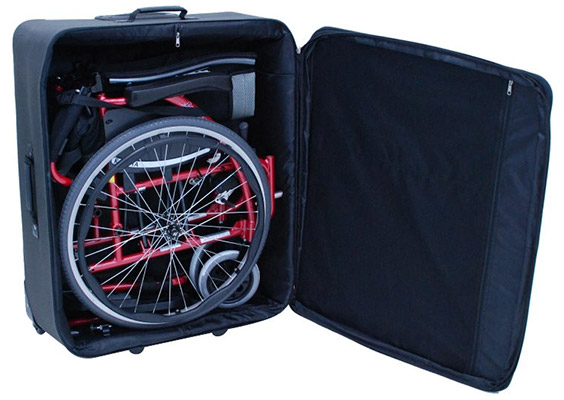
When traveling with a wheelchair there are a few accessories and safety features that can give you peace of mind on the road.
- Wheelchair transport bag: This protects your chair’s fragile components and metal materials from bumps, dings, and the elements.
- Ramp assist: This detachable ramp gives you more flexibility with where you want to park and how you want to move the wheelchair. The user can simply roll up or down the ramp without heavy lifting to get it out of the car and over a curb.
- Crash tested: If you are shopping for a wheelchair, remember to ask your provider if your favorite models have been crash tested for safety. This distinction means that the wheelchair has gone through rigorous testing to determine how it fares in an accident.
- Manual Tie-Downs: It’s always a good idea to have a stash of tie-downs handy for securing your wheelchair in a vehicle.
Final Thoughts: How to Transport a Wheelchair in a Car
If you’re going for a car ride, your wheelchair needs to come with you, of course. That’s why it’s imperative to plan to figure out how it’s going to fit inside.
It comes down to knowing how your wheelchair operates, the size, and the amount of space your car offers.
This article on how to transport a wheelchair unveils plenty of options to move your device easily and safely. Try different methods and find what works best for you!
Resources & References:
- How to Secure a Wheelchair When in a Motor Vehicle, Spinalcord.
- How to Open and Close a Wheelchair, Verywell Health.